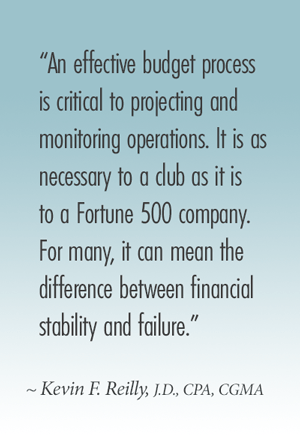As published in Boardroom Magazine, Jan/Feb Edition
Never base your budget requests on realistic assumptions, as this could lead to a decrease in your funding.
– Scott Adams, Dilbert
The budget is not just a collection of numbers, but an expression of our values and aspirations.
– Jacob Lew
A budget is telling your money where to go instead of wondering where it went.
– Dave Ramsey
In the recent past, clubs were forced to cut spending back due to a decline in membership and in spending by the members that remained. However, while membership desires may have been postponed they were not eliminated. The members want a new swimming pool, the grill needs some new furniture, the golf course needs a new irrigation system, the tennis courts need to be resurfaced and by the way, the club down the street is making these improvements. In addition, costs continue to escalate and while wages had been under control, the lowering of the unemployment rate and the new minimum wage in many parts of the country as well as skyrocketing other employee costs have added additional stress on the operations of the club.
Where does the money come from to address the short and long-term, as well as the capital and operational needs of a club? Too often, members will forget that a club has a business as well as a social side to its operations. Generally, expenses are under control but revenue per member while improving, is still below its peak. Clubs must learn to manage members’ expectations. What many members may forget is that ultimately, no matter how funded, they end up paying for the club and its operations. While the federal government cannot pass a realistic budget it can still spend money. A club does not have the option of spending more than it takes in, at least over the long haul.
The financial health of the club cannot be ensured without a detailed knowledge of the costs and revenues involved. The financial software that is prevalent in the industry can provide more detailed information than ever before (and maybe more than we want). Information overload is a real possibility but in today’s environment, it is critical to have and use the tools available. One tool to assist management is through the establishment and use of a budget. An effective budget process is critical to projecting and monitoring operations. It is as necessary to a club as it is to a Fortune 500 company. For many, it can mean the difference between financial stability and failure.
No one budget process is right for every club. The process should be structured to meet the needs of the club; however, some general rules apply. Effective planning requires both a long and a short-term outlook. Finding cash for the next payroll is as critical as financing the next renovation. Long term planning entails setting the club objectives and is part of an overall strategic plan. Short term planning involves cash flow and ensuring revenue is sufficient to operate the club on a daily basis at a level the members want and for which they are willing to pay. This is not always the same thing.
Most clubs, if not all, have a budgeting process. However, it is important to review the established procedures to ensure that the needs of the club are still being met. A process established even last year, never mind ten years ago, may need to be changed. While it is important to compare budgets from year to year, it is more important to realize that the budget is only a tool to more efficiently operate the club.
 A club frequently will have many more people involved in the budget process than will a regular business. To be effective, the group must be as small as possible. The Board of Directors, Finance Committee, (Budget Subcommittee), the department heads, and the general manager should be involved. The budget is a reflection of the business and operational plan. As such, while the members (through the Board) should give the direction of the budget, the operational input should come from professional management. The controller and the club manager, who are ultimately responsible for coordinating the process, assist the budget committee.
A club frequently will have many more people involved in the budget process than will a regular business. To be effective, the group must be as small as possible. The Board of Directors, Finance Committee, (Budget Subcommittee), the department heads, and the general manager should be involved. The budget is a reflection of the business and operational plan. As such, while the members (through the Board) should give the direction of the budget, the operational input should come from professional management. The controller and the club manager, who are ultimately responsible for coordinating the process, assist the budget committee.
Teamwork is essential. Department heads must take ownership and estimate income and expenses by carefully weighing past performance and recognizing current trends. A “guesstimate” is not acceptable. No quicker way exists for the management team to lose creditability than not being able to justify the numbers in the budget with hard data. The next step is to determine the expense estimates for all non-revenue departments under management’s control and responsibility. While the historical cost from prior years is usually the base point, a fresh eye should be given each year to determine if any of the expenses can be reduced or eliminated entirely, or whether certain expenses incurred are for the benefit of only a few members.
Once the preliminary departmental budgets are complete and approved by the manager, the controller should combine all the information for use by the budget committee. This must be a realistic plan containing a monthly estimate of revenue by department, planned cost and expense ratios, and an expected profit or loss realization from each department. Once the operating budget is approved, the capital improvement projects needed for the period must be included. Although many clubs have a separate long-term budget for capital improvements, the cost expected to be incurred in the short-term should be rolled into the master budget.
The budget committee forecasts the anticipated dues revenue for the year and, if appropriate, recommends an increase in dues to balance the budget. Without a detailed budget, dues increases often are difficult to justify. The master budget is submitted to the Board for approval or revision. If the budget process is followed and all excess costs and revenue are considered, the Board must realize that if it cuts the budget, the level of service the members can expected will be impacted. Once approved, the whole team must buy into the budget. The Board must give its support, management must do its best to implement, and the club cannot allow members or committees to by-pass the process and commit the club to expenses that have not been approved.
As with any business, the effectiveness of the budget process depends on the people involved. Variances, either positive or negative should be reviewed and an explanation sought. A failure to follow-up and to hold people accountable makes it a useless exercise. The budget should act as a measuring stick for month-to-month operations. It is an aid to enable the Board and management to evaluate the financial direction of the club and the effectiveness of the club in meeting the needs and desires of its members and to make adjustments as necessary.




